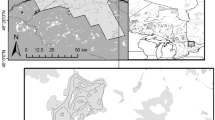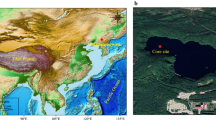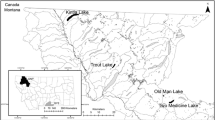Abstract
Climate change involves alterations in seasonality as well as shifts in mean annual temperature. Cold temperate lakes show strong seasonality, with winter ice cover and alternating mixing and stratification periods during the ice-free season. These physical changes are ultimately related to seasonal weather variation and also drive annual phytoplankton succession. Therefore, phytoplankton remains in lake sediment records are potentially useful for reconstructing past seasonal climate signals. With the exception of investigations on varved sediments, however, little research has been carried out on the subject. Here we present two lines of evidence demonstrating that chrysophyte stomatocysts can be useful for inferring past climatic seasonality. First, we show that marked seasonal stomatocyst replacement is related to periods of the main physical processes in the lake. Second, using instrumental climate data and microfossils in sediment cores, we show that two main components of stomatocyst variability over the last ~150 years are related to seasonal fluctuations. The first of these components is related to stomatocysts present during summer stratification that respond to general warming trends, particularly in July and August. The second component relates to stomatocysts typically present in the spring and autumn mixing periods. Numbers of these two stomatocyst types vary inversely in response to variation in spring (April–May) temperatures. The number of stomatocyst types affected by spring temperatures is much greater than those related to summer temperatures. We provide evidence that chrysophyte stomatocysts are an excellent proxy for spring air temperature reconstructions, with little influence from summer or general annual trends. We also show that with relatively little effort, it is possible to categorise the chrysophyte stomatocyst assemblage of a lake to carry out detailed investigation of the record of seasonal changes preserved within the sediment.





Similar content being viewed by others
References
Adrian R, O’Reilly CM, Zagarese H, Baines SB, Hessen DO, Keller W, Livingstone DM, Sommaruga R, Straile D, Van Donk E, Weyhenmeyer GA, Winder M (2009) Lakes as sentinels of climate change. Limnol Oceanogr 54:2283–2297
Agbeti MD, Smol JP (1995) Chrysophyte population and encystment patterns in two Canadian Lakes. J Phycol 31:70–78
Agusti-Panareda A, Thompson R (2002) Reconstruction of air temperature at eleven remote alpine and arctic lake in Europe from 1781 to 1997 AD. J Paleolimnol 28:7–23
Arvola L, George G, Livingstone DM, Jarvinen M, Blenckner T, Dokulil MT, Jennings E, Aonghusa CN, Noges P, Weyhenmeyer A (2010) The impacts of changing climate on the thermal characteristics of lakes. In: George G (ed) The impact of climate change in European Lakes. Springer, Dordrecht, pp 253–292
Battarbee RW, Kneen MJ (1982) The use of electronically counted microspheres in absolute diatom analysis. Limnol Oceanogr 27:184–188
Battarbee RW, Jones VJ, Flower RJ, Cameron NG, Bennion H, Carvalho L, Juggins S (2001) Diatoms. In: Smol JP, Birks HJB, Last WM (eds) Terrestial, Algal and siliceous indicators. Kluwer, Dordrecht, pp 155–202
Bloesh J, Burns NM (1980) A critical review of sedimentation trap technique. Aquat Sci 42:15–54
Capblancq J, Catalan J (1994) Phytoplankton: which, and how much? In: Margalef R (ed) Limnology now: a paradigm of planetary problems. Elsevier, New York, pp 9–36
Catalan J (1988) Physical properties of the environment relevant to the pelagic ecosystem of a deep high-mountain lake (Estany Redó, Central Pyrenees). Oecol Aquat 9:89–123
Catalan J (1989) The winter cover of a high mountain mediterranean lake (Estany Redó, Pyrenees). Water Resour Res 25:519–527
Catalan J (1992) Evolution of dissolved and particulate matter during the ice-covered period in a deep high-mountain lake. Can J Fish Aquat Sci 49:945–955
Catalan J, Camarero L (1991) Ergoclines and biological processes in high mountain lakes: Similarities between summer stratification and the ice-forming periods in Lake Redó (Pyrenees). Verh Int Verein Limnol 24:1011–1015
Catalan J, Fee EJ (1994) Interanual variability in limnic ecosystems:origin, patterns and predictability. In: Margalef R (ed) Limnology now: a paradigm of planetary problems. Elsevier, New York, pp 81–97
Catalan J, Pla S, Rieradevall M, Felip M, Ventura M, Buchaca T, Camarero L, Brancelj A, Appleby PG, Lami A, Grytnes A, Agusti-Panareda A, Thompson R (2002a) Lake Redo ecosystem response to an increasing warming in the Pyrenees during the twentieth century. J Paleolimnol 28:129–145
Catalan J, Ventura M, Brancelj A, Granados I, Thies H, Nickus U, Korhola A, Lotter AF, Barbieri A, Stuchlik E, Lien L, Bitusik P, Buchaca T, Camarero L, Goudsmit GH, Kopacek J, Lemcke G, Livingstone DM, Muller B, Rautio M, Sisko M, Sorvari S, Sporka F, Strunecky O, Toro M (2002b) Seasonal ecosystem variability in remote mountain lakes: implications for detecting climatic signals in sediment records. J Paleolimnol 28:25–46
Catalan J, Camarero L, Felip M, Pla S, Ventura M, Buchaca T, Bartumeus F, De Mendoza G, Miró A, Casamayor EO, Medina-Sánchez JM, Bacardit M, Altuna M, Bartrons M, De Quijano DD (2006) High mountain lakes: Extreme habitats and witnesses of environmental changes. Limnetica 25:551–584
Clarke KR (1993) Non-parametric multivariate analyses of changes in community structure. Aust Ecol 18:117–143
Eloranta P, Sandgren CD, Smol JP, Kristiansen J (1995) Biogeography of chrysophytes in Finish lakes. In: Sandgren CD, Smol JP, Kristiansen J (eds) Chrysophyte algae ecology, phylogeny and development. Cambridge University Press, Cambridge, pp 214–231
Felip M, Catalan J (2000) The relationship between phytoplankton biovolume and chlorophyll in a deep oligotrophic lake: decoupling in their spatial and temporal maxima. J Plankton Res 22:91–105
Felip M, Bartumeus F, Halac S, Catalan J (1999) Microbial plankton assemblages, composition and biomass, during two ice-free periods in a deep high mountain lake (Estany Redó, Pyrenees). J Limnol 58:193–202
Forsström L, Sorvari S, Korhola A, Rautio M (2005) Seasonality of phytoplankton in subarctic Lake Saanajärvi in NW Finnish Lapland. Polar Biol 28:846–861
Forsström L, Sorvari S, Rautio M, Sonninen E, Korhola A (2007) Changes in physical and chemical limnology and plankton during the spring melt period in a subarctic lake. Int Rev Hydrobiol 92:301–325
Gerten D, Adrian R (2002) Effects of climate warming, North Atlantic oscillation, and Nino-Southern Oscillation on thermal conditions and plankton dynamics in northern hemisphere lakes. Scientific World J 2:586–606
Glew JR (1991) Miniature gravity corer for recovering short sediment cores. J Paleolimnol 5:285–287
Jong K, Kamenik C (2011) Validation of chrysophyte stomatocysts-based cold-season climate reconstruction from high-Alpine Lake Silvaplana, Switzerland. J Quaternary Sci, doi:10.1002/jqs.1451
Kamenik C, Schmidt R (2005) Chrysophyte resting stages: a tool for reconstructing winter/spring climate from Alpine lake sediments. Boreas 34:477–489
Kamenik C, Schmidt R, Koinig KA, Agusti-Panareda A, Thompson R, Psenner R (2001) The chrysophyte stomatocyst composition in high alpine lake (Gossenkollesee, Tyrol) in relation to seasonality, temperature and land-use. Beiheft zur Nova Hedwigia 122:1–22
Kristiansen J (1996) Biogeography of freshwater algae—conclusions and perspectives. Hydrobiologia 336:159–161
Larocque-Tobler I, Grosjean M, Kamenik C (2011) Calibration-in-time versus calibration-in-space (transfer function) to quantitatively infer July air temperature using biological indicators (chironomids) preserved in lake sediments. Palaeogeogr Palaeoclimatol Palaeoecol 299:281–288
Legendre P, Legendre L (1998) Numerical ecology. Elsevier, Amsterdam
Livingstone DM (1997) Break-up dates of Alpine lakes as proxy data for local and regional mean surface air temperatures. Clim Change 37:407–439
Livingstone DM (1999) Ice break-up on southern Lake Baikal and its relationship to local and regional air temperatures in Siberia and to the North Atlantic Oscillation. Limnol Oceanogr 44:1486–1497
Livingstone DM, Adrian R, Blenckner T, George G, Weyhenmeyer G (2010) Lake ice phenology. In: George G (ed) The impact of climate change in European Lakes. Springer, Dordrecht, pp 253–292
Noges P, Adrian R, Anneville O, Arvola L, Blenckner T, George G, Jankowski T, Jarvinen M, Maberly S, Padisak J, Straile D, Teubner K, Weyhenmeyer G (2010) The impacts if variation in the climate on seasonal dynamics of phytoplankton. In: George G (ed) The impact of climate change in European Lakes. Springer, Dordrecht, pp 253–292
Pick FR, Nalewajko C, Lean DRS (1984) The origin of a metalimnetic chrysophyte peak. Limnol Oceanogr 29:125–134
Pla S (2001) Chrysophycean cysts from the Pyrenees. J Cramer, Berlin
Pla S, Catalan J (2005) Chrysophyte cysts from lake sediments reveal the submillennial winter/spring climate variability in the northwestern Mediterranean region throughout the Holocene. Clim Dyn 24:263–278
Ramsey FL, Schafer DW (1996) The statistical sleuth: a course in the methods of data analysis. Duxbury Press, Belmont
Reynolds CS (2006) Ecology of phytoplankton. Cambridge University Press, Cambridge
Ruhland K, Paterson AM, Smol JP (2008) Hemispheric-scale patterns of climate-related shifts in planktonic diatoms from North American and European lakes. Glob Change Biol 14:1–15
Rühland KM, Paterson AM, Hargan K, Jenkin A, Clark BJ, Smola JP (2010) Reorganization of algal communities in the Lake of the Woods (Ontario, Canada) in response to turn-of-the-century damming and recent warming. Limnol Oceanogr 55:2433–2451
Sandgren CD (1988) The ecology of chrysophyte flagellates: their growth and perennation strategies as freshwater phytoplankton. In: Sandgren CD (ed) Growth and reproductive strategies of freshwater phytoplankton. Cambridge University Press, Cambridge, pp 9–104
Sandgren CD (1991) Chrysophyte reproduction and resting cysts: a paleolimnologist’s primer. J Paleolimnol 5:1–9
Schmidt R, Kamenik C, Roth M (2007) Siliceous algae-based seasonal temperature inference and indicator pollen tracking ca. 4, 000-years of climate/land use dependency in the southern Austrian Alps. J Paleolimnol 38:541–554
Siver PA, Sandgren CD, Smol JP, Kristiansen J (1995) The distribution of chrysophytes along environmental gradients: their us as biological indicators. In: Sandgren CD, Smol JP, Kristiansen J (eds) Chrysophyte algae ecology, phylogeny and development. Cambridge University Press, Cambridge, pp 232–268
Smol JP (2008) Pollution of lakes and rivers: a paleoenvironmental perspective, 2nd edn. Wiley, Blackwell
Smol JP, Cumming BF (2000) Tracking long-term changes in climate using algal indicators in lake sediments. J Phycol 36:986–1011
Sorvari S, Korhola A, Thompson R (2002) Lake diatom response to recent Arctic warming in Finnish Lapland. Glob Change Biol 8:171–181
Steffen W, Sanderson A, Tyson PD, Jäger J, Matson PA, Moore B III, Oldfield F, Richardson K, Schellnhuber HJ, Turner BL II, Wasson RJ (2004) Global change and the earth system: a planet under pressure. Springer, Berlin
Straile D, Livingstone DM, Weyhenmeyer GA, George DG (2003) The response of freshwater ecosystems to climate variability associated with the North Atlantic Oscillation The North Atlantic Oscillation: climatic significance and environmental impact. Am Geophys Union, pp 263–278
ter Braak CJF, Šmilauer P (1998) Canoco for Windows (40). Centre for Biometry, Wageningen
Thompson AR, Camarero L, Ventura M (2009) On the climate and weather of mountain and sub-arctic lakes in Europe and their susceptibility to future climate change. Freshw Biol 54:2433–2451
Tolotti M, Thies H, Cantonati M, Hansen CME, Thaler B (2003) Flagellate algae (Chrysophyceae, Dinophyceae, Cryptophyceae) in 48 high mountain lakes of the Northern and Southern slope of the Eastern Alps: biodiversity, taxa distribution and their driving variables. Hydrobiologia 502:331–348
Ventura M, Camarero L, Buchaca T, Bartumeus F, Livingstone DM, Catalan J (2000) The main feature of seasonal variability in the external forcing and dynamics of a deep mountain lake (Redo, Pyrenees). J Limnol 59:97–108
Willis KJ, Birks HJB (2006) What is natural? The need for a long-term perspective in biodiversity conservation. Science 314:1261–1265
Zeeb BA, Smol JP (2001) Chrysophytes scales and cysts. In: Smol JP, Birks HJB, Last WM (eds) Terrestrial, algal and siliceous indicators. Kluwer, Dordrecht, pp 203–224
Acknowledgments
This research was supported by a Marie Curie Fellowship (CREATE) as part of the European Community Program under contract number EVK2-CT-2000-50007 and an I3P grant (2007–2010) to Sergi Pla from the Spanish government. This study was funded by Spanish Government research projects: GRACCIE (CSD2007-00067) and ECOFOS (CGL2007-64177/BOS). Finally we would like to thank M. Ventura and L. Camarero for assistance with fieldwork.
Author information
Authors and Affiliations
Corresponding author
Electronic supplementary material
Below is the link to the electronic supplementary material.
Rights and permissions
About this article
Cite this article
Pla-Rabes, S., Catalan, J. Deciphering chrysophyte responses to climate seasonality. J Paleolimnol 46, 139–150 (2011). https://doi.org/10.1007/s10933-011-9529-6
Received:
Accepted:
Published:
Issue Date:
DOI: https://doi.org/10.1007/s10933-011-9529-6




